ILLUSTRATION CONTEST 2024
Column
Behind Drawing Pokémon TCG Illustrations
“Bringing an Illustration to Life” (Part 2)
We asked takuyoa, an illustrator who has worked on dozens of Pokémon Trading Card Game cards, including many Pokémon ex, about the way he creates his illustrations and the appeal of 3D computer graphics (3DCG). We used Greninja ex as an example.
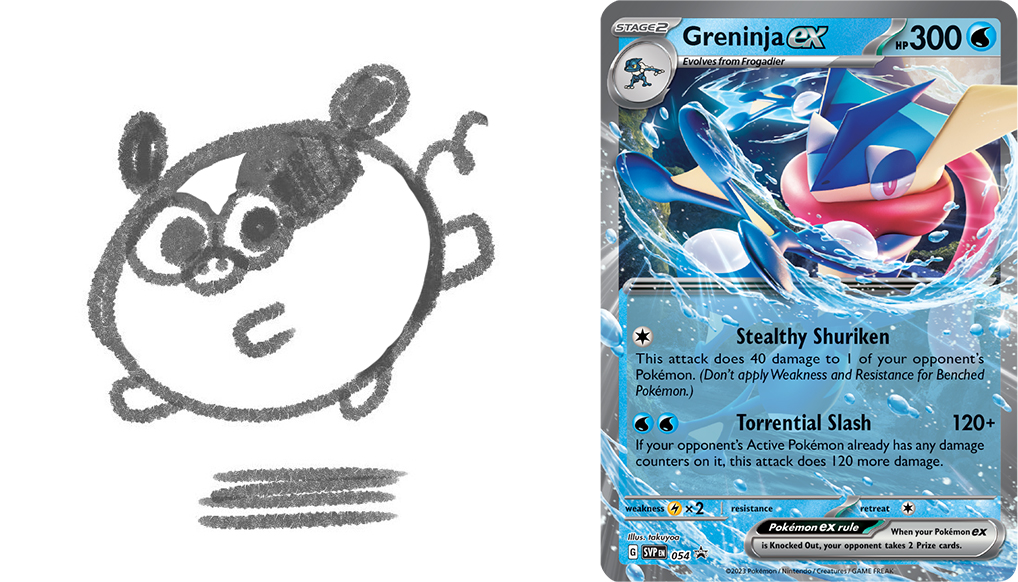
takuyoa
CG Illustrator.
He has been illustrating Pokémon TCG cards since 2021.
He won the second Pokémon Card Game Illustration Grand Prix held exclusively in Japan between 2019 and 2020. He mainly works on Pokémon ex illustrations and is also in charge of package illustrations for the Chinese version of the Pokémon TCG. His favorite Pokémon is Lechonk.
「Greninja ex」 Illus. takuyoa
Included in the Pokémon TCG: Greninja ex Battle Deck
What are Pokémon ex?
They are special Pokémon with higher-than-normal HP and powerful attacks and Abilities. Basic Pokémon, Stage 1 Pokémon, and Stage 2 Pokémon can be Pokémon ex.
These cards have special illustrations where the Pokémon seems to pop out of the frame.
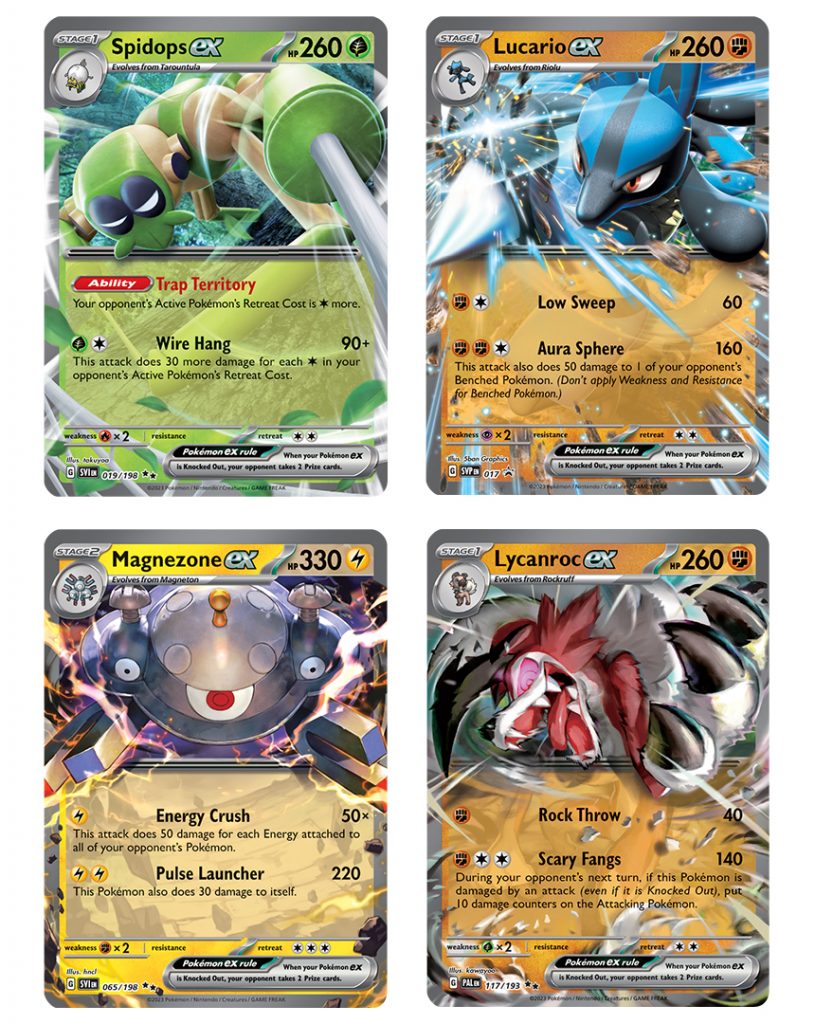
「Spidops ex」 Illus. takuyoa
Included in the Pokémon TCG: Scarlet & Violet expansion
「Lucario ex」 Illus. 5ban Graphics
Included in the Pokémon TCG: Lucario ex Battle Deck
「Magnezone ex」 Illus. hncl
Included in the Pokémon TCG: Scarlet & Violet expansion
「Lycanroc ex」 Illus. kawayoo
Included in the Pokémon TCG: Scarlet & Violet—Paldea Evolved expansion
“What I think about when illustrating”
―Tell us about the guiding principles you follow when creating Pokémon TCG illustrations.
takuyoa: I try to make my illustrations as cool as possible. I want them to be cool in an obvious way. “Cool!” is the first thing that I want people to think when they see them.
―You work on both 3DCG and 2D illustrations. Which type did you start with?
takuyoa: I started with 2D illustrations. When the second Pokémon Card Game Illustration Grand Prix was held between 2019 and 2020, it featured a 3DCG illustration category, which is what motivated me to try my hand at it.
I used to work as a 3DCG animator. My job was making 3DCG character models move. I was already familiar with 3DCG at that point, so creating my own 3DCG illustrations didn’t feel particularly daunting. Drawing from that experience, I applied to the Pokémon Card Game Illustration Grand Prix.
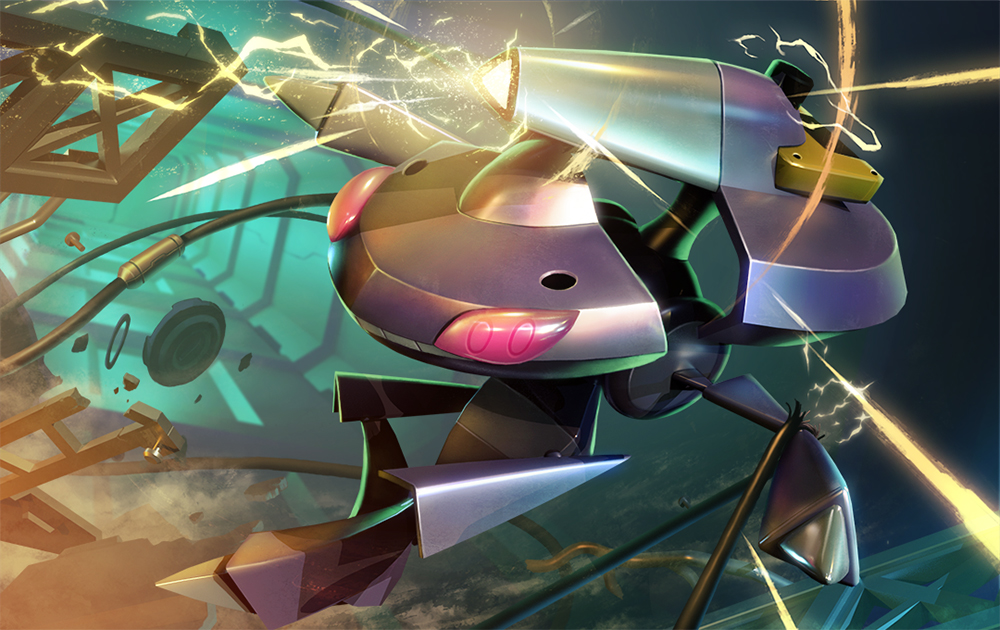
The Genesect illustration that won the second Pokémon Card Game Illustration Grand Prix.
―So, drawing 3DCG illustrations wasn’t difficult for you to begin with.
takuyoa: Exactly. I’ve been drawing 2D illustrations since high school and started creating 3DCG ones in vocational school. I think that learning how to do both helped me achieve a more flexible approach to the challenges of 3DCG illustration.
―What supplies or software do you use to create your illustrations?
takuyoa: For the illustration I submitted to the second Pokémon Card Game Illustration Grand Prix, I used Blender and Photoshop. Blender is a free and open-source application for creating 3DCG animations. These days, I use Maya for 3DCG illustrations and Photoshop for both finishing and creating effects for 3DCG illustrations or for drawing 2D ones.
―Blender and Maya can both be used to create 3DCG illustrations, but are they different?
takuyoa: They’re quite different. Maya has a lot of features, while Blender is easy to use and has a shallow learning curve.
If you are starting out with 3DCG illustration, you may want to try using Blender.
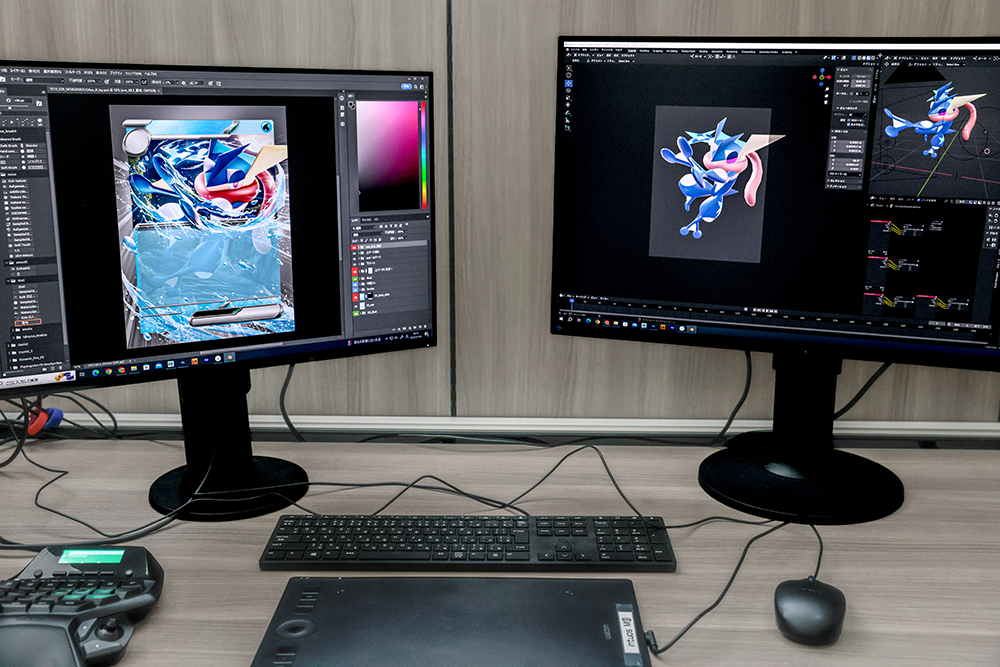
Step 1: Research
―We would like to hear about your process for creating 3DCG illustrations. How do you do your research?
takuyoa: When I start an illustration, I receive some informational material and read it thoroughly. I try to understand everything written in it, such as the Pokémon’s characteristics, their little quirks, and so on. I also use the Pokémon TCG Card Database, where I can check older cards featuring that Pokémon. I do that to see what compositions have already been used in the past. I wouldn’t want to illustrate something too similar to an existing card. For me, research involves deepening my understanding of the Pokémon subject and deciding on the composition to use.
Step 2: Drafting and Supervision
―How do you create your drafts? Please tell us about your process.
Your illustrations are already surprisingly detailed at this stage.
takuyoa: The good thing about 3DCG illustration is that it’s easy to visualize the final product from the draft stage. For 3DCG illustrations, I try to draw drafts that are as close as possible to what I want to end up with.
―A major feature of Pokémon ex illustrations is the Pokémon and certain effects seemingly popping out of the frame. How do you go about establishing the composition and the pose of the Pokémon during the drafting phase?
takuyoa: I try to make the face of the Pokémon as large as possible so that it looks cool and strong even when sized for cards. Next, I experiment with different poses, and I think of the effects last. When it comes to posing and effects, I pay particular attention to the way they “flow.” Using Greninja ex as an example, the arm moves from the background to the foreground in a beautiful, flowing way. I also drew the tongue in a dynamic way, making it follow the arm. The water effect shows that moving trajectory beautifully.
―Do you like coming up with different compositions and poses for Pokémon?
takuyoa: For each illustration, I draw two to three drafts on average. Here, I started by drawing pose A [image on the left], so I could go on and freely create variations, like pose B [image in the center] and pose C [image on the right], which are both quite different from the original draft. I create these additional drafts to make sure the finished product will be as good as possible.

takuyoa created three drafts for Greninja ex. In the end, draft B, in the middle, was chosen.
―The supervision of illustrations is carried out by both Creatures Inc. and The Pokémon Company. Among the feedback they’ve given you to make your illustrations more representative of the Pokémon subjects and the Pokémon TCG, is there anything that has particularly stuck with you?
takuyoa: I often receive feedback about the colors I use. I use some very dramatic coloring on the Pokémon to make them look as cool as possible, but this can sometimes make them deviate from their original colors. That’s one of the things I struggle with the most.
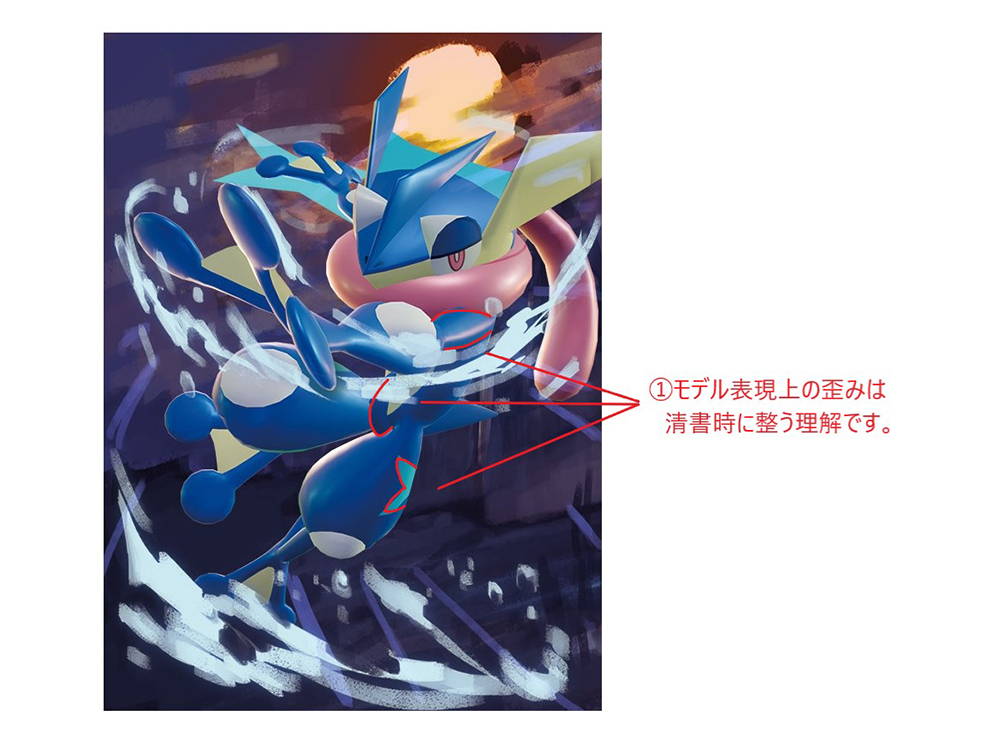
Translation for the note above:
- ①Assuming that the modeling discrepancies will be fixed later.
Step 3: Final Copy Creation and Supervision
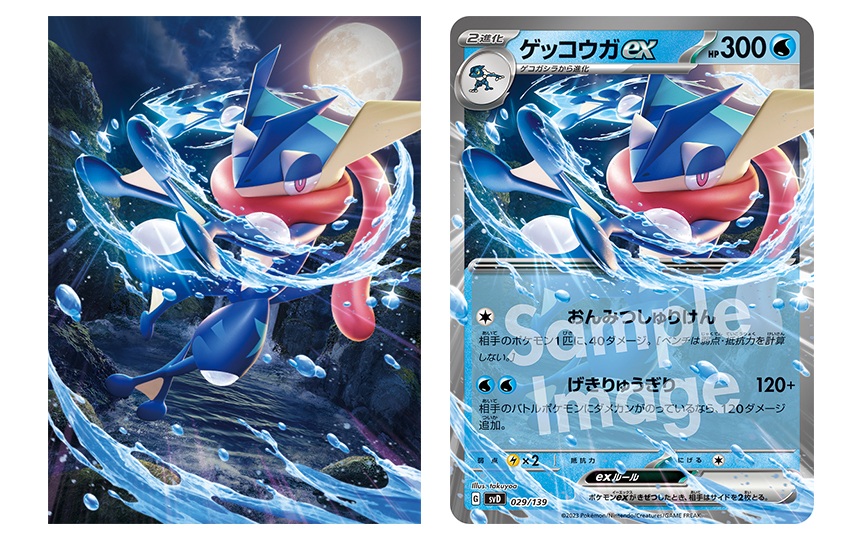
―How do you create the final copy? Please tell us about your method.
takuyoa: I use Photoshop to apply 2D retouches to the Pokémon I drew in 3DCG.
So, my illustrations are 2D/3D hybrids. I create as much as I can with 3DCG and use 2D for the details for which it would be more effective to do so.
―So, you create the effects in 2D and overlay them on the 3DCG model.
takuyoa: The Genesect illustration I won the second Pokémon Card Game Illustration Grand Prix with was also done in this way. I first drew Genesect in 3DCG and then retouched it in 2D.
―We heard that sometimes you also redraw the faces of Pokémon in 2D.
takuyoa: For example, when I was drawing the 3DCG illustration of Pidgeot ex, I noticed that its facial proportions looked odd. So I made some adjustments to Pidgeot’s face in 2D. This is why creating the final copy takes so long. I adjust anything that doesn’t look right.
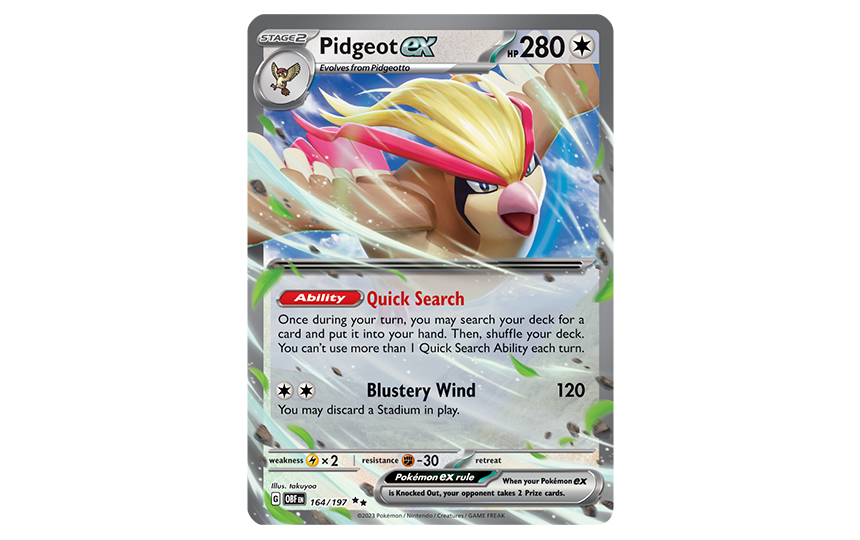
「Pidgeot ex」 Illus. takuyoa
Included in the Pokémon TCG: Scarlet & Violet—Obsidian Flames expansion
―How do you make your Pokémon subjects look more real?
takuyoa: Realism is always difficult to achieve. To me, Pokémon are cute creatures. I feel that if I pursue realism too much, they won’t fit in the Pokémon world anymore.
Revavroom, for example, is based on an engine. When I was drawing the Revavroom ex illustration, I made sure to give its body a metallic feel and to show that its tires are as hard as rock. It’s important not to pursue realism too much in details like these. Otherwise, you risk getting away from the Pokémon worldview.
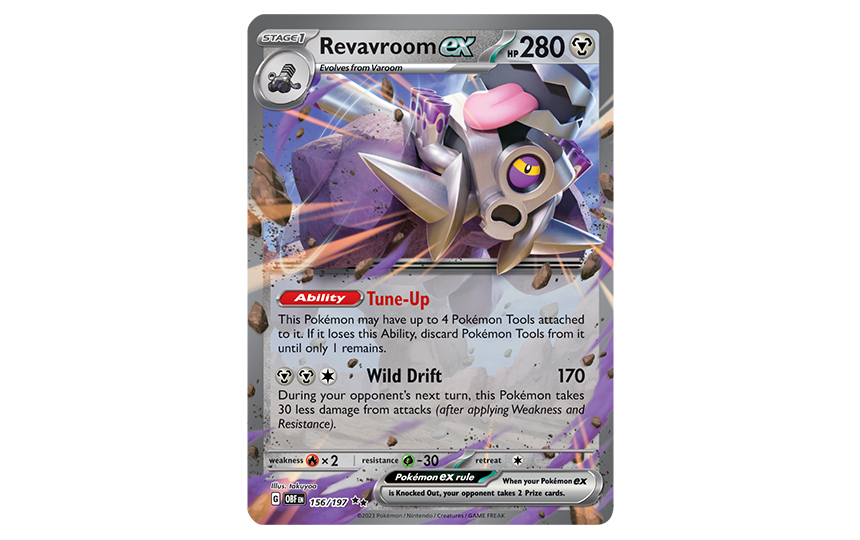
「Revavroom ex」 Illus. takuyoa
Included in the Pokémon TCG: Scarlet & Violet—Obsidian Flames expansion
―Balancing this realism must be very difficult.
takuyoa: Yes, I personally believe it to be so. That’s why creating the final copy involves paying attention to different things than when drawing drafts.
―How do you apply finishing touches such as visual effects and other adjustments for the final copy, and what do you pay attention to during this step?
takuyoa: I’d never drawn a proper water effect before, so I experimented with real photographs of water. However, it didn’t look as cool as I’d hoped, so I decided to draw it from scratch. I wanted to make it clear that the water was coming out from Greninja ex’s fingertips, and I kept drawing and erasing, drawing and erasing… That took a ridiculous amount of time (laughs). Natural objects such as water and fire are difficult to draw.
―Do you mean that it is difficult to portray things like water and lightning in general? Or do you mean that it is difficult to draw them in a way that looks cool for the illustration?
takuyoa: Drawing them in general is the difficult part. For example, it is difficult to draw water and electricity moving with force. Things like flames also can’t hold a definite shape, which is what makes this so difficult. If I try to start with photographs by processing them, it never comes out quite as I’d like. When I draw effects based on natural objects, especially water, fire, and lightning, I know that I’ll have to put in a lot of effort.
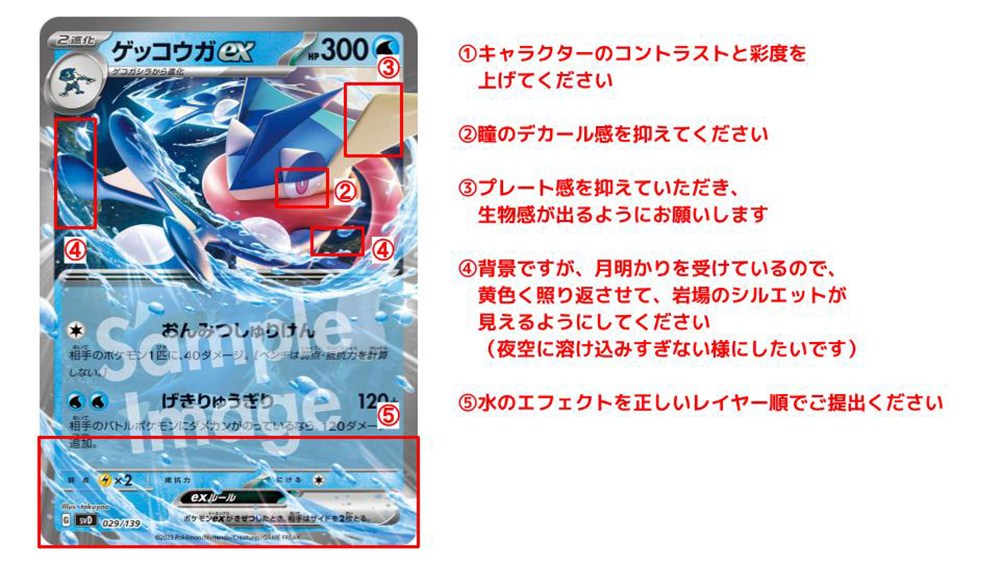
There is a final round of supervision, used to refine the smallest details of the illustration and how it looks on the card.
Translation for the note above:
- ①Increase the contrast and saturation of the character.
- ②Avoid making the eye look like a decal.
- ③Make this look more organic.
- ④The background should be a bit more yellow because of the light from the moon. (So Greninja doesn’t blend in with the night sky.)
- ⑤Rearrange the layers in the correct order.
Step 4: Completion!
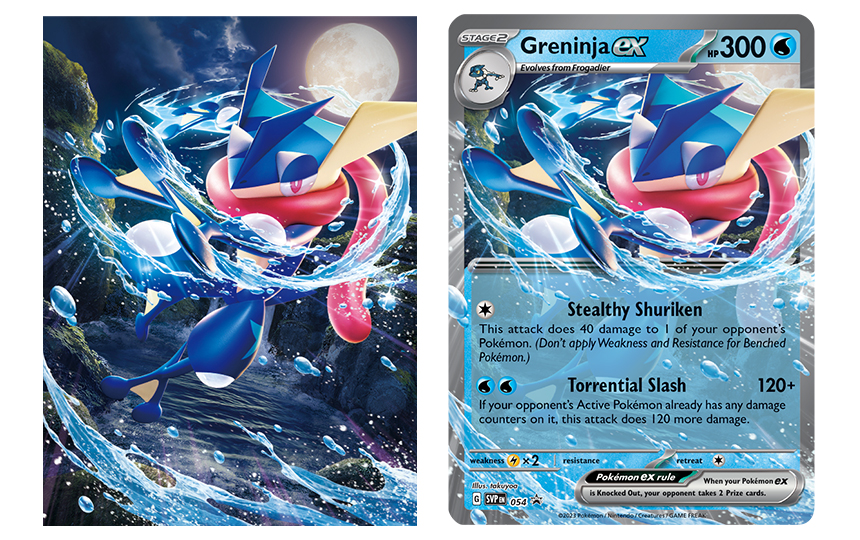
―So, this is the final step in creating the illustration. Is there any part of the process that you find particularly fun or challenging?
takuyoa: I particularly enjoy drawing the drafts. That is when I think about how to make the Pokémon pose. It’s fun because I can think of what pose would make the Pokémon look the coolest—particular poses that only I could think up—and such. I’m particularly happy when I come up with something unique!
―What is the biggest appeal of drawing 3DCG illustrations as compared to 2D ones?
takuyoa: More than the drawing part, I enjoy coming up with the key elements of the illustration such as poses, effects, and their positions. 3DCG illustrations help put these elements together very quick, and they allow you to apply the change in as many ways as you want. You can enjoy the feeling of getting closer to the finished illustration much faster.
In Conclusion
―What would you like to say to the Pokémon Trading Card Game Illustration Contest 2024 applicants?
takuyoa: Nowadays, you can easily start 3DCG illustration with free software that has all the functions you may need. I’m sure many of you reading this will be applying with 2D illustrations, but the experience you have drawing in 2D can be useful when creating 3DCG illustrations as well! I’d be happy to see a lot of applications with 3DCG illustrations.
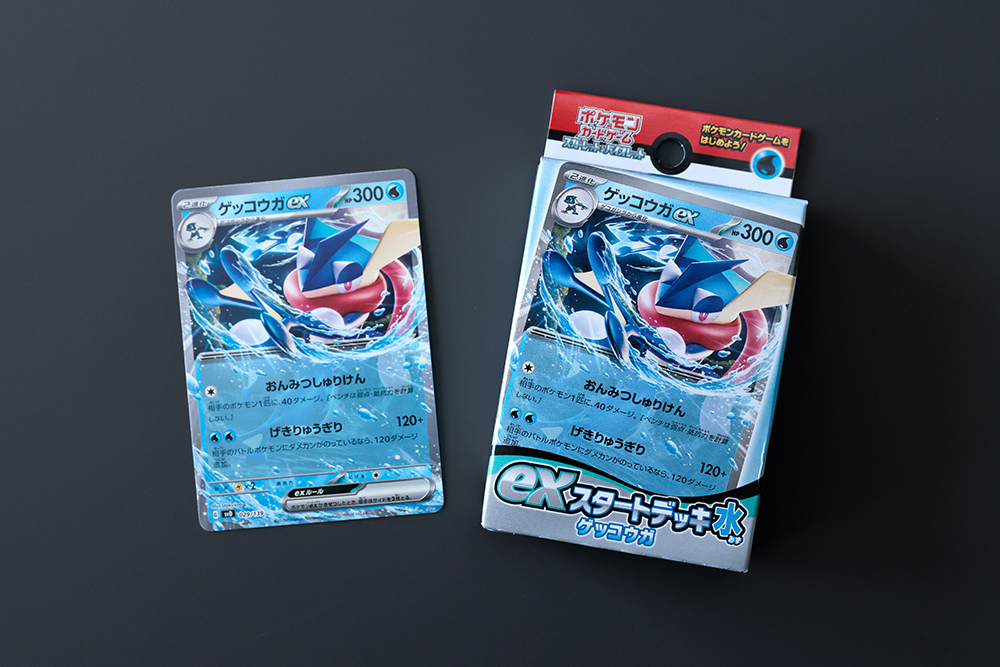
Composition and text: Shusuke Motomiya (One-up) Photos: Kayoko Yamamoto